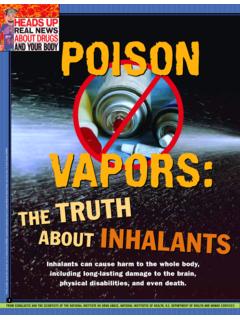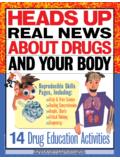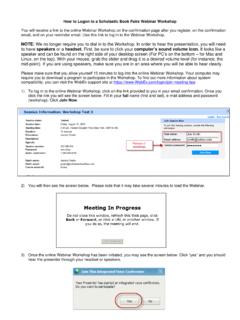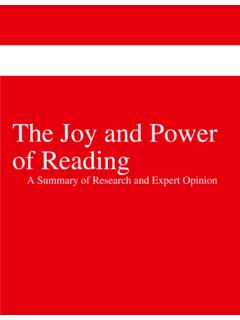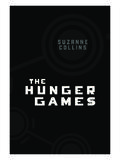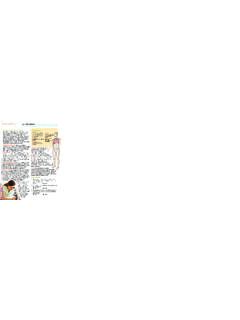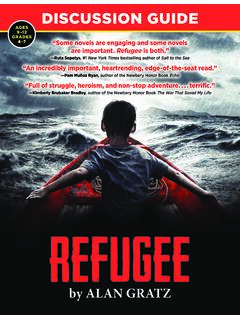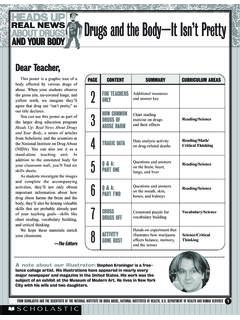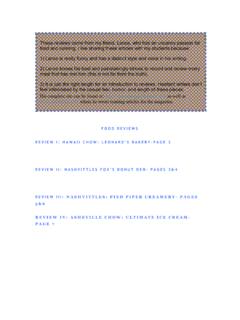Transcription of FROM SCHOLASTIC AND THE SCIENTISTS OF THE …
1 AND YOUR BODYREAL NEWSHEADS UPHEADS UPABOUT DRUGS FROM SCHOLASTIC AND THE SCIENTISTS OF THE national institute ON DRUG ABUSE, national INSTITUTES OF HEALTH, DEPARTMENT OF HEALTH AND HUMAN SERVICESSTEPHEN KRONINGER(ILLUSTRATION)14 Drug Education Activities Reproducible SkillsPages, Including:>>Body & Brain Science>>Reading Comprehension>>Graphs, Charts>>Critical Thinking >>SequencingFROM SCHOLASTIC AND THE SCIENTISTS OF THE national institute ON DRUG ABUSE, national INSTITUTES OF HEALTH, DEPARTMENT OF HEALTH AND HUMAN SERVICESILLUSTRATIONS BY STEPHEN KRONINGER; BRAIN DIAGRAM (PAGE 2) BY 5W INFOGRAPHICSDear Teacher,One of the most important things you can do as ateacher is to give your students information about thehealth effects of drug abuse. Together with theNational institute on Drug Abuse (NIDA), we ve puttogether this 16-page book of reproducibles, full offacts and activities on drugs of abuse.
2 This book is justone component of our ongoing drug educationprogram, Heads Up: Real News About Drugs andYour Body, a partnership between NIDA andScholastic Inc. These skills pages can be used alone orto support and extend the feature articles thatappeared in your classroom magazine in the 2002-2003 school year and are continuing this year. This book includes an introduction to the brain, thatcrucial organ so vulnerable to drugs of abuse. Then,we focus on the health effects of specific drugs,including marijuana, inhalants, nicotine, steroids,prescription drugs, club drugs, heroin, and cocaine. While you can use these reproducibles to supportadrug education, health, or human-body sciencecurriculum, the activities extend into other areas. Inorder to complete the activities, students must readcharts and graphs and complete diagrams.
3 They mustread and practice universal skills such as criticalthinking, pre- and post-reading strategies, inferencing,and recall. We hope you find these pages useful acrossyour curriculum. The EditorsBrain, p. 2:Cerebral cortex: thinking,seeing, hearing, and sense of touch; Limbicsystem: produces feelings and emotions;Cerebellum: coordinates movements involvedin everyday tasks; Brain stem: controlsbreathing, food digestion, and heart beat;Nucleus accumbens: involved in reward andfeelings of pleasure. Students responses to how they ve used each part of the brainwill , p. 3:1. hemp; 2. joint; 3. blunt; 4. THC; 5. cannabinoid; 6. neurons; 7. hippocampus; 8. cerebellum; 9. cortex; 10. , p. 4:True; False; False; True;False; False; True; False; False; True. Nicotine, p. 6:1. b; 2. a; 3. c; 4. a; 5. , p.
4 7:Hair male-pattern baldness;Bones stunted growth; Brain/limbicsystem roid rage; Arm/needle injectionsite HIV/AIDS; Heart heart attack;Liver cysts and liver Drugs, p. 9:Answers can include anyof the effects listed on page 10 under therespective , p. 10:Student answers will , p. 13:For the correct order of thesentences, start from What is heroin? andgo counter-clockwise. Answers for DrawYour Own Conclusion may s the Question? p. 15:1. What aresteroids, heroin, and cocaine? 2. What is ahollowed-out cigar filled with marijuana? 3. What are MDMA, inhalants, andmarijuana? 4. What is a street name forMDMA? 5. What are MDMA, cocaine,and/or LSD? 6. What are cocaine, heroin,and marijuana? 7. What are LSD, MDMA,and marijuana?Prescription Drugs, p. 16:1. F; 2. T; 3. F; 4. F; 5. KEY For past and current articles in the Heads Up series, as well as activities and teaching support, go For free reprints of the 2002-2003 Heads Up series,call 1-800-729-6686 and refer to NCADI MS927; the accompanying Teacher s Edition is NCADI MS928.
5 For free copies of the 2002-2003 Heads Up poster, call1-800-729-6686 and refer to NCADI AVD165. FROM SCHOLASTIC AND THE SCIENTISTS OF THE national institute ON DRUG ABUSE, national INSTITUTES OF HEALTH, DEPARTMENT OF HEALTH AND HUMAN SERVICES1 Contents234-5678-910-1112-1314-1516 PAGECONTENTYOUR BRAIN AT-A-GLANCE Anintroduction to the parts of the brainACTIVITY: Parts of the Brain: What Are They Good For?(Skills: Recall, reading comprehension, inferencing )THE WORD ON MARIJUANAA glossary of terms ACTIVITY: Fill-in-the-Blank (Skills: Recall, reading comprehension, inferencing)THE TOP 10 THINGS YOU NEED TO KNOW ABOUT INHALANTSA list of facts about inhalants ACTIVITY: True or False Quiz(Skills: Recall, reading comprehension)STEROIDS: ALL-OVER HORROR How anabolic steroids affect the body and brainACTIVITY: The Body on Steroids(Skills: Recall, completing a diagram)RAVE REALITIES: THE TRUTH ABOUT CLUB DRUGSA fact sheet on club drugsACTIVITY: Club Drug Cheat Sheet(Skills: Completing a graphic organizer)THE COCAINE COURSEF requently Asked Questions about cocaineACTIVITY: The Cocaine Course(Skills: Pre- and post-reading strategies)NICOTINE NEWSA line graph shows the decline in teen nicotine useACTIVITY.
6 Multiple Choice Quiz(Skills: Graph reading)MIXED-UP ABOUT HEROINAn out-of-order report on heroinACTIVITY: Draw Your Own Conclusion (Skills: Sequencing, drawing conclusions)OUTSMART THE CHARTA comprehensive chart on the common drugs of abuse ACTIVITY: What s the Question? (Skills: Reading a chart, recall, comprehension)APRESCRIPTION FOR PAINA bargraph ofstatistics on prescription drug abuseACTIVITY:True or False Quiz(Skills: Reading a bar graph)FROM SCHOLASTIC AND THE SCIENTISTS OF THE national institute ON DRUG ABUSE, national INSTITUTES OF HEALTH, DEPARTMENT OF HEALTH AND HUMAN SERVICES2 USES: COPYING MACHINE, OPAQUE PROJECTOR, OR TRANSPARENCY MASTER FOR OVERHEAD PROJECTOR. SCHOLASTIC INC. GRANTS TEACHER-SUBSCRIBERS PERMISSION TO REPRODUCE THIS SKILLS SHEET FOR USE IN THEIR CLASSROOMS. COPYRIGHT 2003 BY SCHOLASTIC INC.
7 ALL RIGHTS Brain At-a-GlanceThe largest part of your brain is the cerebralcortex. When it s functioning normally, thissection takes care of thinking, seeing, hearing, andthe sense of touch. Next is the cerebellum. The cerebellumcoordinates movements you do everyday, such asbrushing teeth and riding a above the spinal cord, a small section ofyour brain called the brain stemcontrols basicfunctions, such as breathing, digesting food, andmaintaining your heartbeat. Then, there s the limbic system, also known asthe emotional brain. This is where feelings likefear and passion are born. SCIENTISTS have identified a reward pathway inthe brain that includes the nucleus we do something that is key to survival,such as eating when we are hungry, the rewardpathway is stimulated. Most addictive drugs alsostimulate this reward pathway, often more thannatural rewards, such as food.
8 How do drugs affect your brain? Once in thebrain, drugs of abuse are similar in size and shapeto brain chemicals called neurotransmitters. Braincells release and absorb these natural chemicals inorder to send and receive messages to and fromeach other. Drugs disrupt this delicatecommunication system, and can hurt your drugs changes the way the brain works. The brain is very important. It controls body functionssuch as breathing, walking, and thinking. Discover the different parts of your brain and the jobs they , learn how drugs can get in the way. After reading, complete the diagram activity below. PARTS OF THE BRAIN: WHAT ARE THEY GOOD FOR? For each brain part, write one of the functions it performs. Plus, include one way you ve used this part of your brain SYSTEMNUCLEUS ACCUMBENSCEREBRAL CORTEXBRAIN STEM_____CEREBELLUMFROM SCHOLASTIC AND THE SCIENTISTS OF THE national institute ON DRUG ABUSE, national INSTITUTES OF HEALTH, DEPARTMENT OF HEALTH AND HUMAN SERVICES3 USES: COPYING MACHINE, OPAQUE PROJECTOR, OR TRANSPARENCY MASTER FOR OVERHEAD PROJECTOR.
9 SCHOLASTIC INC. GRANTS TEACHER-SUBSCRIBERS PERMISSION TO REPRODUCE THIS SKILLS SHEET FOR USE IN THEIR CLASSROOMS. COPYRIGHT 2003 BY SCHOLASTIC INC. ALL RIGHTS :slang term for a cigar filled with marijuanaCannabinoid Receptors: sites on the surface of braincells where the active ingredient in marijuanaattaches to produce the drug s effectsCerebellum: part of the brain involved in bodymovement Cerebral Cortex: part of the brain involved in higherthinkingDopamine: a brain chemical (or neurotransmitter)that helps nerve cells communicateHemp:the plant marijuanacomes fromHippocampus: part of thebrain s limbic system thathelps with learning and memoryJoint: slang term for marijuana rolled into a cigaretteNeurons: cells in the brain; also found in the spinalcord and other organsTHC: tetrahydrocannabinol, the main activeingredient in marijuanaThe drug marijuana is the dried, shredded leaves of the _____ plant.
10 While there aresev eral methods of use, marijuana is often rolled into a cigarette, called a _____, orstuffed into a hollowed-out cigar, called a _____, and drug s effects on the brain are caused by the main active ingredient, tetrahydrocannabinol, or_____. This chemical attaches to specific receptors in the brain called_____ receptors. When it binds to these receptors, it interferes with the normalcommunication between brain cells, or _____. Several parts of the brain have a lot of these receptors, including the _____, whichdeals with learning and memory; the _____, which helps with body movement; andthe cerebral _____, which is in charge of higher , research shows that THC triggers the release of _____, a chemical thathelps nerve cells are some of the key words you need to understand to discuss the drugmarijuana and its effects.
